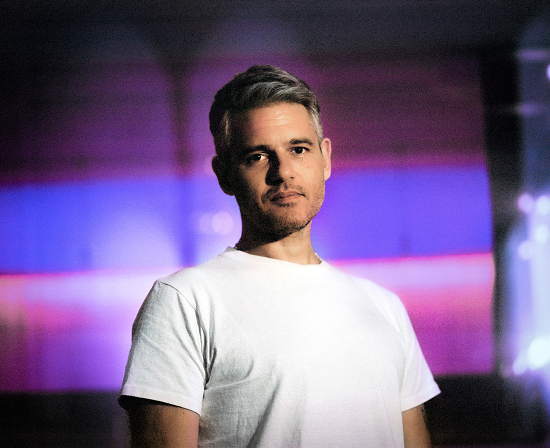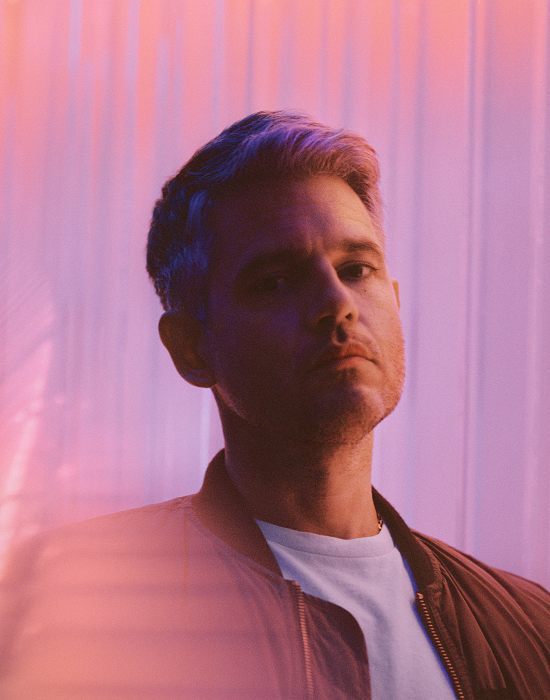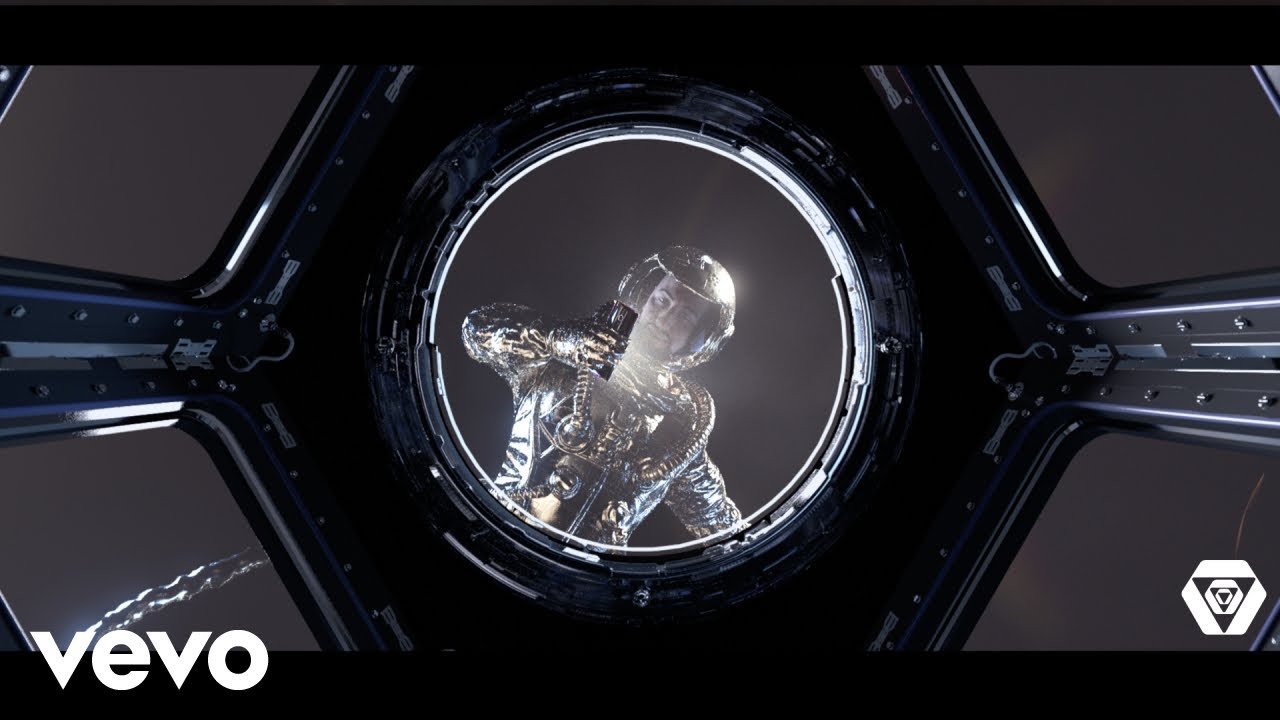Photos by Alex Waespi
In a small studio in North London called The Crypt, a room exactly big enough for me and four others to sit socially distanced in the middle, Paul Epworth is about to present his debut album. At a variety of different heights, about fifteen speakers line the walls on all sides, precisely placed so they can best overwhelm their listeners. Projected over a screen at the front of the room, in grand, serif letters reads VOYAGER, Presented in 360 Reality Audio. The album whirrs into gear, each speaker acting as its own sonic thruster as earth-shaking rushes of glorious noise emanate one after the other from every direction. A gargantuan, galaxy-sized beat emerges, before the commanding voice of Vince Staples takes control. A few minutes later, hypercharged FlyLo-esque beats burst from all sides, weaving in and out of one another as the prodigiously gifted young rapper Ishmael’s frantic flow takes over.
The 360 Audio, a state-of-the-art format that Epworth likens to the jump from mono to stereo, lends a heightened physicality to the record’s enormously varied sonic palette. At the end of ‘Cosmos’, interweaving staccato synths jab at the top of your head, while a lovely psychedelic organ line simultaneously weaves its way through your chest. Sometimes a glistening harp arpeggio or a sweep of strings or a cosmic rush of gospel voices will swarm gently around the back of your ears. Sometimes all the speakers attack en masse in one huge crescendo; if sound could travel in space, perhaps this is what a supernova might sound like.
This extraordinarily textured record was a long time in the making. Epworth, now 46, first signed a deal to release a solo album “over a decade ago, when I was young and good looking,” he jokes over Zoom, a few weeks prior to my trip to The Crypt. For all his success working with artists like Adele, Mumford And Sons and Florence + The Machine, his efforts to step out under his own name resulted in nothing but “bullshit! It was total nonsense,” he says. “There was no identity or any thread running through it. Some of the tracks were really good but there wasn’t that ‘thing’ at the centre.”
When working as a producer, Epworth has a habit of pushing his artists to come up with a proper thread for their record. “If someone comes into the studio and one track’s a house tune, the next is an acoustic guitar tune, it confuses people. But if you have, say, a house track with an acoustic guitar, and then an acoustic guitar track with some electronic programming, sonically you begin to create a cognitive thread so people don’t get lost en route.” Eventually, Epworth laughs, “I realised I hadn’t applied any of that to myself!”
In search of that cognitive thread, Epworth looked backwards to the music that first captured him, the concept-driven prog and early electronic music that his father – a scientist – would play in the house while Epworth grew up, the likes of Pink Floyd, Yes and Wendy Carlos. Simultaneously, he happened to be listening to a lot of jazz. “I was gradually going through the Sun Ra catalogue, going through the Brainfeeder catalogue, and also exploring the South London jazz scene and bands like The Comet Is Coming.” The theme of his own album began to emerge, “these dots connecting in a way that said to me ‘look, this electronic, space-themed jazz-influenced seventies concept album could be a thing!’”
Vince Staples was the first of the album’s considerable cast of vocalists to climb aboard. Epworth played him a song he’d had sitting on a hard drive, “something I knew could be really great.” Staples enjoyed it, took it way, and a week later sent back his vocal – slick, assured and grand. “As soon as I had that, this piece of anthemic shoegaze rap with a Boney M ‘Night Flight To Venus’ chorus, suddenly I could play it to people and they’d say ‘I see what you’re doing.’” From there it was a question of “knocking on doors,” some of which opened and some of which didn’t. Securing Kool Keith for the glitchy ‘Distant Planets’, for example, was a simple matter of messaging him on Twitter. “Within two hours he sent me back a vocal.”

It was the relatively unknown young MC Ishmael, however, who would prove to be the album’s most crucial feature. “That’s when things started to really take shape,” Epworth says. “Without him appearing at the right moment and being this wild, psychedelic, open-minded, young, hungry, enthusiastic and incredibly talented human being, the record would never have got finished.” Epworth was after someone who could deliver “that intense Andre 3000 hecticness,” to the rapid, Brainfeeder-worthy beat he’d recorded for the track ‘Hyperspace’ and in Ishmael he found his man. He offered a quick brief on the record’s themes. “I said ‘it should feel like you’ve just got away from Planet Earth and you’re about to go into a Millennium Falcon hyperspace drive, or the stargate from 2001, psychedelic technicolour,’ and straight away he just went all Timothy Leary. That’s the fun part of collaborating, it’s like being a couple of nerds in a bedroom, giggling like Beavis and Butthead.”
At one point during the Voyager sessions, conversation turned to the topic of the record’s dream feature. The obvious answer: “How amazing would it be to get David Bowie to do a guest vocal?” Epworth recalls. This was before Bowie’s death, but a hint of starstruck wonderment comes to his voice even now. “We were like, obviously that’s impossible, but let’s just think about it for a bit.” There was one song emerging from the sessions “that I was trying to steer towards the Bowie/Floyd sound, this track ‘Cosmos’ which was originally called ‘Methylene Blue’, which is apparently some kind of experimental drug that clears junk DNA out of your body that they’re researching for long periods of space travel.” One day in early January 2016, Epworth was playing an early form of the track to his wife on the acoustic guitar. “She said ‘that sounds great, you should record that’, and then she picked up her phone and the news notification said, ‘Bowie dead’. The synchronicity of that was just way too strange. So the first half of that song was recorded the day Bowie died, it flipped to represent this transition between life and death. How as I was playing the song I was thinking ‘One day you could knock on David Bowie’s door and he might hear it and say ‘maybe I’ll be on the record,’ and then going straight past the moment where there was no possibility in the universe that that would happen.”
There were lots of these little moments of synchronicity during the making of Voyager, like when samples from sci fi films or Sun Ra records would instantly fit over Epworth’s beats, already in perfect key and time. “It felt like there were channels open.” When struggling to find someone to mix the album, US producer Mike Dean happened to be in Epworth’s studio working with Madonna for her Madame X LP. “He couldn’t smoke weed downstairs with her, so he came upstairs to pull up a blunt with me every couple of hours. He happened to say ‘do you want a hand finishing it?’ and I said ‘hell yeah! Is the universe speaking to us?’”
There was one more moment of synchronicity that defines Voyager over all the others, however. On the very day the record was finished, his father – whose music collection had been so influential to its making, and whose favourite film 2001: A Space Odyssey had been projected on repeat during sessions – passed away, nine months after being diagnosed with a brain tumour. When Epworth first started looking back at those prog LPs of his youth for inspiration his father had not yet fallen ill. “While he was alive and well and might have gone on for another 30 or 40 years, I was still subconsciously using all these things that he’d passed on to me culturally.” During his father’s long battle with the tumour, the album was all Epworth would work on. “I guess I knew if I took on any other work on through that period I’d miss these last opportunities with him, so it meant I was able to say goodbye. There’s a lot of him on the album. Maybe in a metaphysical sense part of him made the record through me.” As well as finishing the record on the day of his father’s death, the day he sent it over to his label happened to be on his father’s birthday. “I know [his illness] was meant to be a part of the story of the record,” the producer says.
Voyager is an exploration of inner space as much as it is outer space. It’s a concept album, named after the first man-made probe to reach interstellar space, but the LP makes more than one kind of trip. “I discovered what the message of the record was while I was making it. It’s my own spiritual journey, and it’s about my own experience of where we are as a species,” the producer says. “I’m not trying to sound like Sting or anything, but it’s also about consciousness and how we relate together as humans, and our place on this small little blue dot floating in the infinity of space.”

In the fabric of its sounds – a mixture of ultra-modern production and vintage equipment – it is also a journey across the generations of production that Epworth’s career has covered. “I left AIR Studios as an engineer, just as they had bought their first ProTools rigs. I’ve come from the analogue era, through the whole digital era, to the point where audio manipulation is the norm, not just for avant-garde auteurs.” The decision to format it with that 360 Reality Sound, the way it’s being played in The Crypt, brings his career up the very edge of modernity. The first time he heard it played on those speakers himself, Epworth was overwhelmed. “When we decided to do the whole album in Sony 360 I thought ‘oh fucking hell, I’ve got to go and approve it.’ I dragged myself to The Crypt, and sat through the record in full for the first time. It was the first time I’d enjoyed it, ever. It was synesthetic. I cried, actually.”
In many ways, the immense inward and outward journey that reaches its conclusion with Voyager began a decade ago, with those early, failed attempts to get a solo record off the ground – “Maybe this album wouldn’t have happened without that prototype, so I understood what not to do,” he muses – and the way its failure pushed Epworth to explore the primordial source of his passion for music in search of conceptual drive. After years enabling some of the world’s biggest artists to speak their truth, the album is the culmination of the producer’s long, arduous journey to blast off on his own.




